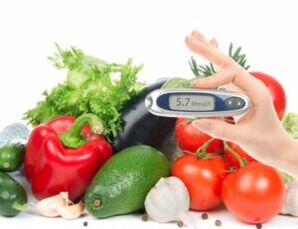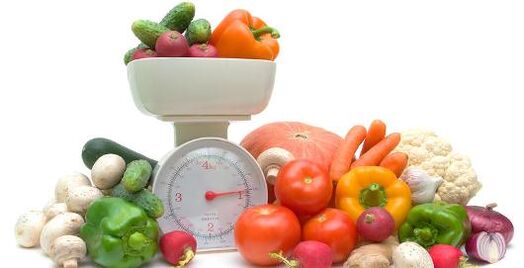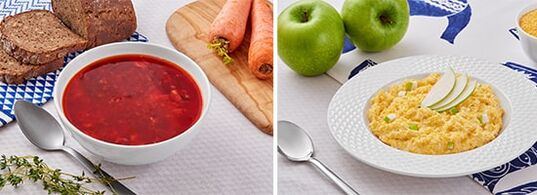
Diabetes mellitus is a chronic endocrine pathology in which metabolism is disrupted due to lack or improper functioning of the hormone insulin.
There is a difference between insulin-dependent diabetes (type 1) and non-insulin-dependent diabetes (type 2).
In the first case, patients should inject insulin preparations, because the hormone in their body is produced in insufficient quantities or is completely absent.
In another species, the interaction of insulin with cells is disrupted.
Despite the different mechanisms of pathology development, the main role in its therapy is dietary nutrition.
Dietary characteristics for diabetics
In the past, the food inhibition system was the only way to curb hyperglycemia or high glucose levels. Now the diet of patients has been significantly expanded. Diabetics are advised to follow a few important rules for effective blood glucose control.
Patients should not be hungry or overeating. These conditions are dangerous to their health. You need to eat so that the amount of carbohydrates consumed is evenly distributed throughout the day.
General dietary requirements:
- fractional diet (at least 6 times a day);
- calculation of consumed carbohydrates;
- limiting animal fats;
- introduction of plant foods into the diet;
- preferring steamed food, in the oven, cooked;
- avoiding or limiting carbohydrate-rich foods;
- balanced diet;
- replacement of sugar with substitutes;
- consuming foods with coarse fiber;
- adherence to the drinking regime;
- reduction of salt intake;
- elimination of alcohol.
You can diversify your diet by buying utensils that allow you to cook food without oil.
In order for carbohydrates to be absorbed more slowly and not cause spikes in the increase in blood sugar, the following recommendations should be followed:
- Eat foods that are coarse or grainy, such as crumbly grains instead of mashed or cooked.
- Meals should not be hot because temperature affects glucose intake.
- Fiber in food inhibits the absorption of simple carbohydrates and helps remove cholesterol.
- Simple carbohydrates are best consumed after the main meal.
The menu may include foods that contain simple carbohydrates with fiber, such as fruits and berries. Glucose absorption is slowed down if consumed with protein (protein cream) or fat. However, remember that "slow" carbohydrates are also absorbed into the bloodstream, increasing sugar.

Differences in diet in type 1 and type 2 diabetes mellitus
Since the reasons for the increase in blood sugar in the first and second types of disease are different, there are several approaches to the diet of patients. For insulin-dependent patients, the diet is more varied. Because they more often suffer from this pathology at a young age, high-calorie foods are included in the diet. When assembling the diet, the entered cereal units are taken into account.
In type 2 diabetes, the main task of the diet is weight loss. In this case, the menu is calculated according to the calorie content of the products. The patient's diet is stricter. They are not allowed sugar, fatty foods and foods that increase cholesterol.
Bread unit

The concept of "bread unit" (XE) was introduced to take into account the quantitative composition of carbohydrates. For 1 XE is considered 25 g of bread or 12 g of sugar (carbohydrate). Diagram of bread units is necessary for diabetics to calculate short-acting insulin.
1 XE requires 2-4 units. insulin. The individual need for additional insulin administration according to XE is determined using a self-monitoring diary, which the patient must keep.
For one meal a diabetic should not eat more than 7 XE. The main load of carbohydrates occurs in the first half of the day.
In order not to constantly calculate bread units by product weight, we created product tables taking into account their energy value.
What is the glycemic index of foods
The glycemic index (GI) is an indicator that shows how much blood sugar can be increased by using a certain product in relation to glucose intake.
Foods with a high GI (70 or more):
- baby
- glucose;
- sugar;
- mashed potatoes;
- sweet soda;
- sweets - corn sticks, rice pudding.
Average GI (56-69):
- melon;
- banana;
- oatmeal;
- black bread.
The lowest GIs have:
- milk products;
- milk;
- fruits;
- peas, beans, lentils and other legumes.
The rate of absorption is affected by cooking, food integrity and temperature.
In diabetes mellitus, only foods with medium and low GI are allowed.
List of allowed and forbidden products
Dietary principles for diabetics with different types of disease differ. However, there are foods that endocrinologists do not recommend eating.
The list of prohibited foods includes:
- fried potatoes, french fries, chips;
- sweet fruit - grapes;
- fatty meat;
- smoked meat;
- Preserved food in oil;
- pate;
- sweet curd, curd mass;
- sweet yogurts;
- margarine;
- white bread and white flour pastries;
- juices from the store;
- soda;
- alcohol;
- sweets, chocolate;
- jam;
- condensed milk;
- fast food.
Patients will have to fall in love with these foods and drinks:
- mineral water;
- bar compote;
- vegetable juices;
- freshly squeezed juices from sweet and sour berries and fruits;
- unsweetened citrus fruits;
- frozen and fresh berries;
- nonfat dairy products without sugar;
- dietary meat - chicken, turkey, veal, rabbit meat;
- cabbage;
- legumes;
- mushrooms;
- tomato;
- Eggplant;
- cabbage;
- asparagus;
- broccoli;
- milk;
- wholemeal bakery products;
- sea food;
- fish.
To reduce the starch content in vegetables and cereals, it is recommended to soak them before cooking.
Rules for compiling menus
When compiling the menu, it is worth considering not only the load of carbohydrates and calories in food, but also the activity of diabetics. Exercise lowers blood sugar. In type 1 diabetes, it is recommended to eat 1 XE for every hour of physical activity. This will prevent you from changing your bolus insulin dose.
In obesity, the dietitian helps to compose the diet, taking into account the energy content (caloric content) of food and daily energy expenditure during physical activity. The calculation takes into account the sex, age and degree of obesity of the patient. It is allowed to organize fasting days (with type 2 diabetes). However, fasting is contraindicated in such patients.
The general condition of diabetics is taken into account when preparing the menu. Pregnant and breastfeeding women, adolescents and debilitated patients need protein intake. If the patient has kidney or liver damage, ketoacidosis, protein intake is reduced.
Do not forget about other nutrients that are involved in metabolism: vitamins, zinc, copper, manganese. Due to the patient's tendency towards pathologies of the cardiovascular system, the salt content in foods is reduced.
Sample menu for a week
Monday
- breakfast: buckwheat porridge, protein bran bread with butter, tea;
- snack: cabbage salad with egg;
- lunch: chicken soup, vegetable salad with herbs, legumes with white meatballs, compote, diabetic rye bread;
- afternoon snack: bread with yogurt;
- dinner: zrazy steamed with fish, rye bread, vegetable salad;
- snack: fermented milk drink.
Tuesday
- breakfast: oatmeal, whole wheat bread with butter, tea;
- snack: salad of parsley, onion and mushrooms;
- lunch: pea soup, roasted chicken with vegetables, vegetable salad, whole grain bread, drinks;
- afternoon snack: fermented baked milk with biscuits;
- dinner: stewed fish with vegetables, cereal bread, juice;
- snack: yogurt.
Wednesday
- breakfast: Artek porridge, protein bran bread with butter, coffee;
- snack: celery, apple and carrot salad;
- lunch: borsch, buckwheat porridge with steamed cutlet, sauerkraut salad, protein bread, compote;
- afternoon snack: cottage cheese with fruit;
- dinner: bigos with sauerkraut and meat, soft bran bread, juice;
- snack: baked apple.
Thursday
- breakfast: eggs, rye bread with butter, tea;
- snack: cottage cheese with yogurt;
- lunch: green borscht, roasted eggplant with meat, tomato salad with low-fat sour cream, rye bread, compote;
- afternoon snack: cottage cheese pudding with tea;
- dinner: meat stew with vegetables, rye bread, drinks;
- snack: kefir bread.

Friday
- breakfast: pearl barley, whole wheat bread with butter, tea (chicory, coffee);
- snack: fruit salad with yogurt;
- lunch: fish soup, fish cutlet with vegetable garnish, paprika and cucumber salad, cereal bread, citrus drink;
- afternoon snack: bread with milk;
- dinner: steamed cutlet with milk sauce, porridge, whole grain bread, lemonade;
- snack: fruit.
Saturday
- breakfast: omelet with veal, protein bread with cheese, tea;
- snack: cottage cheese with berries;
- lunch: mushroom soup, porridge with cooked (roasted) meat, canned peas with onions and herbs, protein bran bread, compote;
- afternoon snack: oatmeal cookies with fermented baked milk;
- dinner: zucchini stuffed with meat, porridge, protein bran bread, drinks;
- snack: fermented baked milk.
Sunday
- breakfast: brown rice with minced meat and cabbage (rolls), rye bread with butter, tea;
- snack: bread with yogurt;
- lunch: meatball soup, omelet with chicken, red cabbage salad, rye bread, drinks;
- afternoon snack: kefir with biscuits;
- dinner: fish cakes, baked potatoes, rye bread, drinks;
- snack: biscuit with milk.
The trial menu is compiled by a nutritionist. In the future, the diabetic himself supplements the diet, taking into account the recommendations of the doctor.
Ready meals for diabetics
To eat properly with diabetes mellitus, you need to invest a lot of time and effort. Most diabetics simply do not have enough time to properly compile a menu and prepare food, so I would like to tell you now about the company Cryodieta, which helps people with diabetes to make life easier.
Cryodieta is a delivery service of ready-made and delicious food not only for diabetics, but also for people who want to lose weight. The menu was prepared by competent experts - nutritionists and doctors.
Thanks to the use of special "shock freezing" technology, you only need to heat the food in the microwave or multi-cooker and eat it deliciously. At the same time, freezing retains all the nutrients.
The main advantages of "Cryodiet":
- production of products in the ecologically clean area of the Novgorod region;
- delivery without delay in person;
- a variety of foods;
- shock freezing (preserves food without preservatives);
- more affordable prices compared to competitors.
Examples of dishes

The ready-to-eat food delivery service for diabetics works in big cities, so if you want to eat healthy diet food and don’t spend a lot of time on it, order a weekly menu on the official website.
Sugar substitutes
Sweeteners can be added to dishes so that patients do not suffer from a lack of sweets. They are divided into three groups:
- Carbohydrates - fructose, sorbose, xylitol, sorbitol, molasses.
- Protein sweeteners - miraculin, monelin.
- Synthetic - aspartame, sodium cyclamate.
Endocrinologists recommend the use of the natural sweetener stevia. Its leaves contain a glycoside complex, which is 200 times sweeter than sugar. The sweetener is useful for obesity, high cholesterol and high blood sugar. Due to its ability to normalize metabolism, stevia helps restore the antitoxic function of the liver.
Plant glycosides stimulate immunity, reduce sugar levels, and have a beneficial effect on the digestive and endocrine systems. Drinks that contain stevia extract correct the desire for sweet and fatty foods and help you get rid of extra pounds.
High blood sugar is not a death sentence for patients if you learn how to make a diet and use healthy sweets instead of sugar. Also, do not forget the obligatory consultation with an endocrinologist.































































